Business Law Report: UK Legal System, Business Impact and Disputes
VerifiedAdded on 2021/02/21
|15
|5018
|54
Report
AI Summary
This report provides a comprehensive overview of UK business law, beginning with an introduction to the legal framework and the importance of law in business operations. It explores the principle of parliamentary sovereignty and details the various sources of UK law, differentiating between primary and secondary sources. The report then examines the role of the government in lawmaking, differentiating between its executive, legislative, and judicial functions, along with an analysis of statutory and common law. Furthermore, it illustrates the impact of company, employment, and contract law on businesses, providing examples of how these laws affect business operations and decision-making. The report also discusses different types of business organizations, comparing unincorporated and incorporated businesses, and concludes with an overview of dispute resolution methods. This report offers valuable insights into the practical application of business law within the UK context.

Business Law
Paraphrase This Document
Need a fresh take? Get an instant paraphrase of this document with our AI Paraphraser
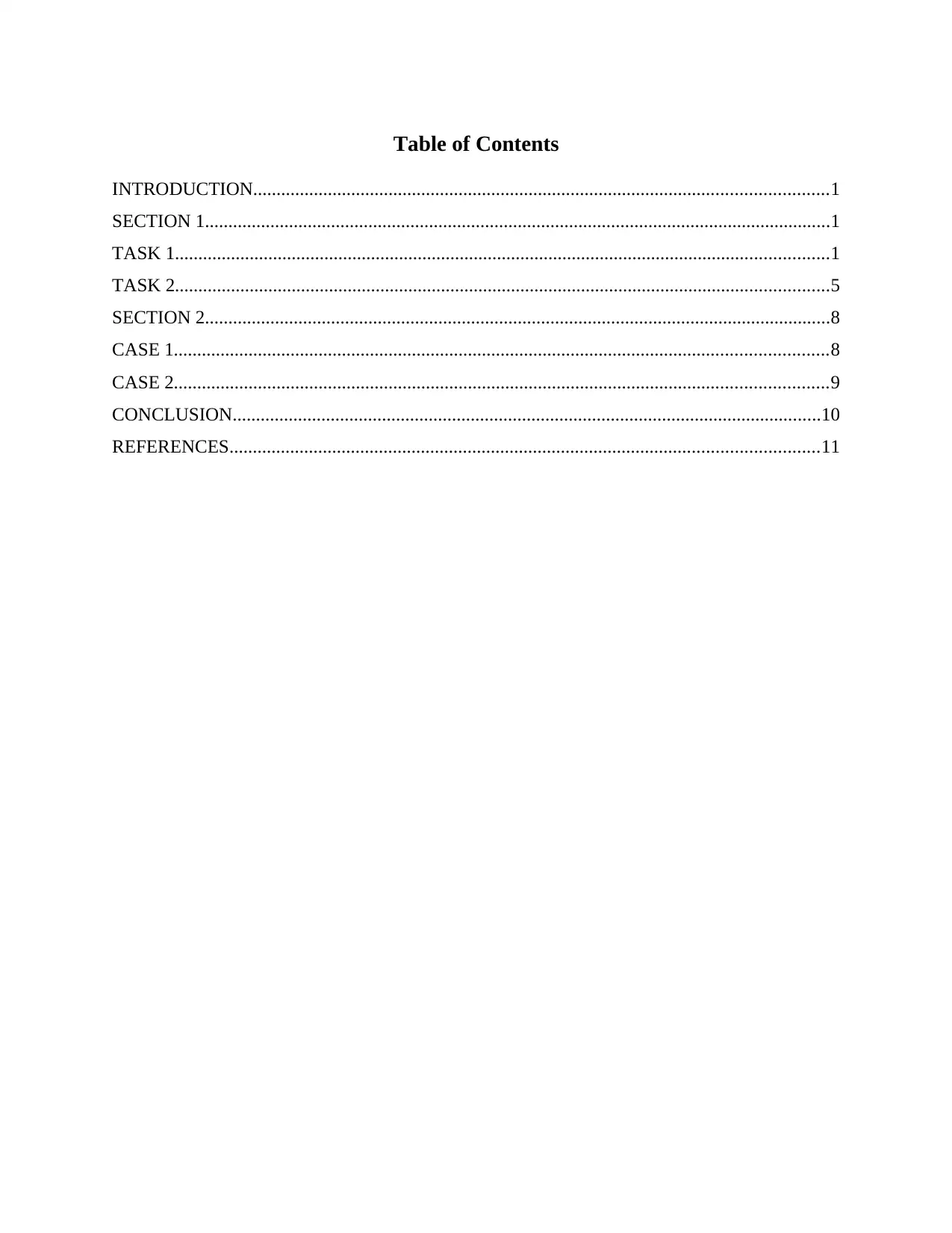
Table of Contents
INTRODUCTION...........................................................................................................................1
SECTION 1......................................................................................................................................1
TASK 1............................................................................................................................................1
TASK 2............................................................................................................................................5
SECTION 2......................................................................................................................................8
CASE 1............................................................................................................................................8
CASE 2............................................................................................................................................9
CONCLUSION..............................................................................................................................10
REFERENCES..............................................................................................................................11
INTRODUCTION...........................................................................................................................1
SECTION 1......................................................................................................................................1
TASK 1............................................................................................................................................1
TASK 2............................................................................................................................................5
SECTION 2......................................................................................................................................8
CASE 1............................................................................................................................................8
CASE 2............................................................................................................................................9
CONCLUSION..............................................................................................................................10
REFERENCES..............................................................................................................................11

⊘ This is a preview!⊘
Do you want full access?
Subscribe today to unlock all pages.

Trusted by 1+ million students worldwide
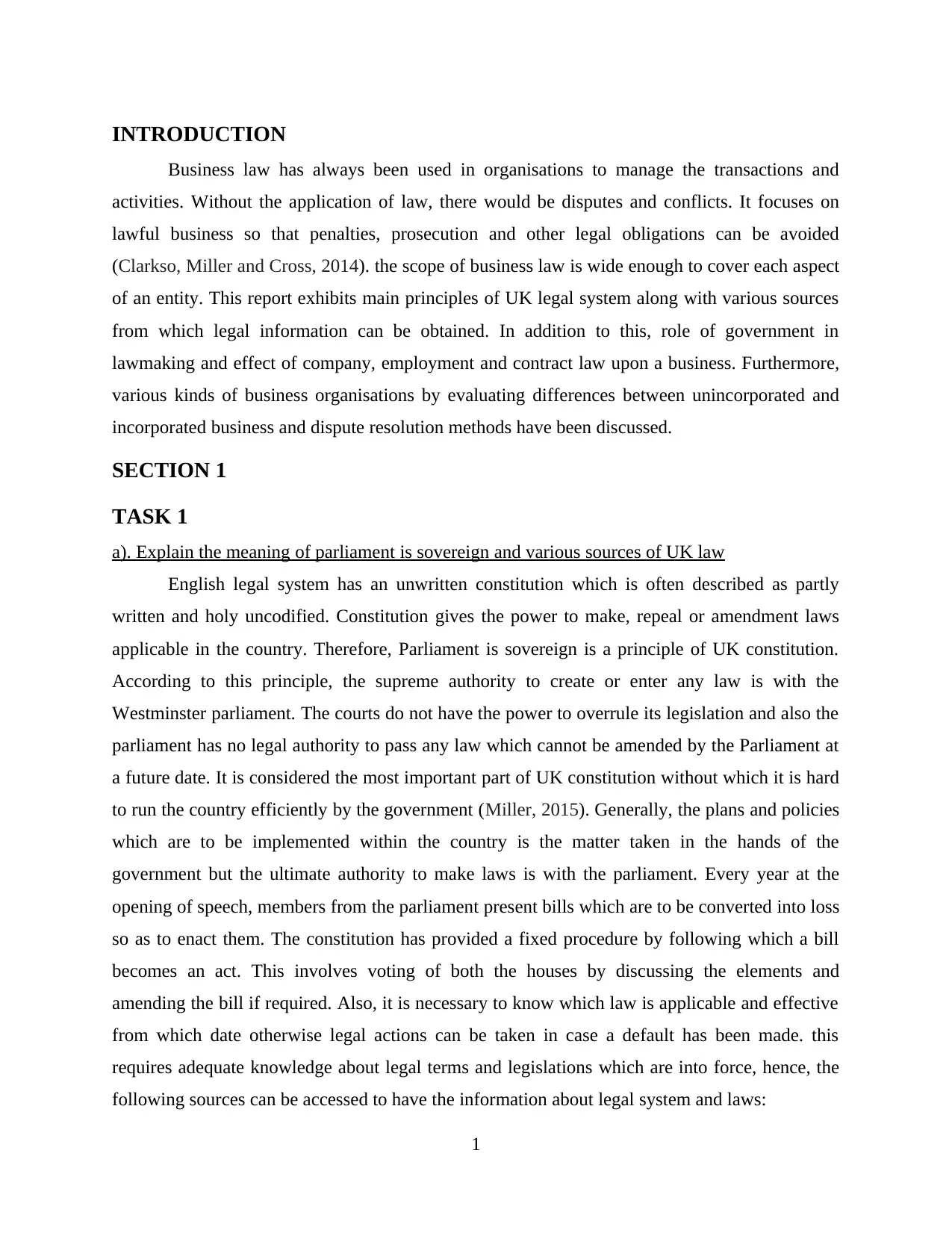
INTRODUCTION
Business law has always been used in organisations to manage the transactions and
activities. Without the application of law, there would be disputes and conflicts. It focuses on
lawful business so that penalties, prosecution and other legal obligations can be avoided
(Clarkso, Miller and Cross, 2014). the scope of business law is wide enough to cover each aspect
of an entity. This report exhibits main principles of UK legal system along with various sources
from which legal information can be obtained. In addition to this, role of government in
lawmaking and effect of company, employment and contract law upon a business. Furthermore,
various kinds of business organisations by evaluating differences between unincorporated and
incorporated business and dispute resolution methods have been discussed.
SECTION 1
TASK 1
a). Explain the meaning of parliament is sovereign and various sources of UK law
English legal system has an unwritten constitution which is often described as partly
written and holy uncodified. Constitution gives the power to make, repeal or amendment laws
applicable in the country. Therefore, Parliament is sovereign is a principle of UK constitution.
According to this principle, the supreme authority to create or enter any law is with the
Westminster parliament. The courts do not have the power to overrule its legislation and also the
parliament has no legal authority to pass any law which cannot be amended by the Parliament at
a future date. It is considered the most important part of UK constitution without which it is hard
to run the country efficiently by the government (Miller, 2015). Generally, the plans and policies
which are to be implemented within the country is the matter taken in the hands of the
government but the ultimate authority to make laws is with the parliament. Every year at the
opening of speech, members from the parliament present bills which are to be converted into loss
so as to enact them. The constitution has provided a fixed procedure by following which a bill
becomes an act. This involves voting of both the houses by discussing the elements and
amending the bill if required. Also, it is necessary to know which law is applicable and effective
from which date otherwise legal actions can be taken in case a default has been made. this
requires adequate knowledge about legal terms and legislations which are into force, hence, the
following sources can be accessed to have the information about legal system and laws:
1
Business law has always been used in organisations to manage the transactions and
activities. Without the application of law, there would be disputes and conflicts. It focuses on
lawful business so that penalties, prosecution and other legal obligations can be avoided
(Clarkso, Miller and Cross, 2014). the scope of business law is wide enough to cover each aspect
of an entity. This report exhibits main principles of UK legal system along with various sources
from which legal information can be obtained. In addition to this, role of government in
lawmaking and effect of company, employment and contract law upon a business. Furthermore,
various kinds of business organisations by evaluating differences between unincorporated and
incorporated business and dispute resolution methods have been discussed.
SECTION 1
TASK 1
a). Explain the meaning of parliament is sovereign and various sources of UK law
English legal system has an unwritten constitution which is often described as partly
written and holy uncodified. Constitution gives the power to make, repeal or amendment laws
applicable in the country. Therefore, Parliament is sovereign is a principle of UK constitution.
According to this principle, the supreme authority to create or enter any law is with the
Westminster parliament. The courts do not have the power to overrule its legislation and also the
parliament has no legal authority to pass any law which cannot be amended by the Parliament at
a future date. It is considered the most important part of UK constitution without which it is hard
to run the country efficiently by the government (Miller, 2015). Generally, the plans and policies
which are to be implemented within the country is the matter taken in the hands of the
government but the ultimate authority to make laws is with the parliament. Every year at the
opening of speech, members from the parliament present bills which are to be converted into loss
so as to enact them. The constitution has provided a fixed procedure by following which a bill
becomes an act. This involves voting of both the houses by discussing the elements and
amending the bill if required. Also, it is necessary to know which law is applicable and effective
from which date otherwise legal actions can be taken in case a default has been made. this
requires adequate knowledge about legal terms and legislations which are into force, hence, the
following sources can be accessed to have the information about legal system and laws:
1
Paraphrase This Document
Need a fresh take? Get an instant paraphrase of this document with our AI Paraphraser
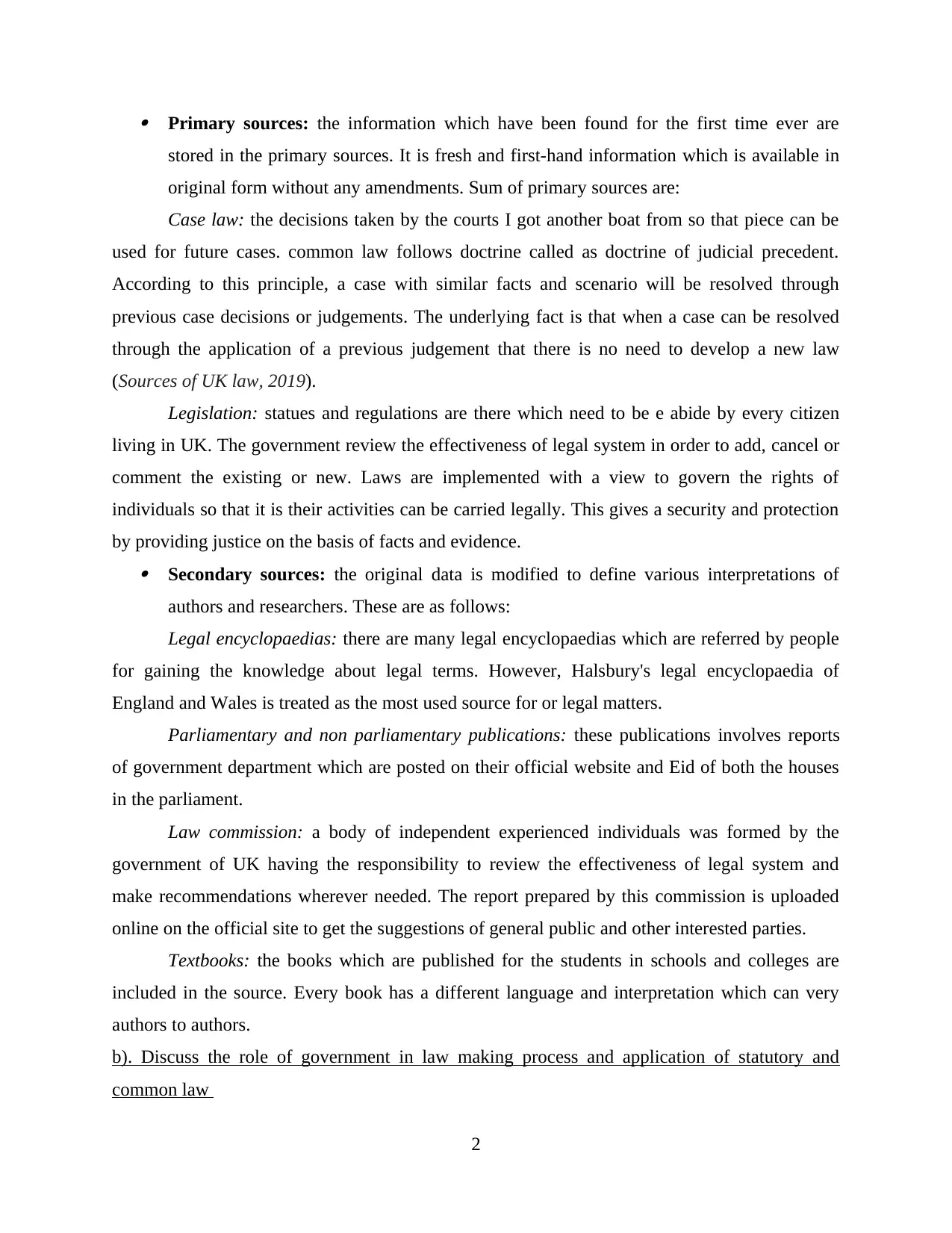
Primary sources: the information which have been found for the first time ever are
stored in the primary sources. It is fresh and first-hand information which is available in
original form without any amendments. Sum of primary sources are:
Case law: the decisions taken by the courts I got another boat from so that piece can be
used for future cases. common law follows doctrine called as doctrine of judicial precedent.
According to this principle, a case with similar facts and scenario will be resolved through
previous case decisions or judgements. The underlying fact is that when a case can be resolved
through the application of a previous judgement that there is no need to develop a new law
(Sources of UK law, 2019).
Legislation: statues and regulations are there which need to be e abide by every citizen
living in UK. The government review the effectiveness of legal system in order to add, cancel or
comment the existing or new. Laws are implemented with a view to govern the rights of
individuals so that it is their activities can be carried legally. This gives a security and protection
by providing justice on the basis of facts and evidence. Secondary sources: the original data is modified to define various interpretations of
authors and researchers. These are as follows:
Legal encyclopaedias: there are many legal encyclopaedias which are referred by people
for gaining the knowledge about legal terms. However, Halsbury's legal encyclopaedia of
England and Wales is treated as the most used source for or legal matters.
Parliamentary and non parliamentary publications: these publications involves reports
of government department which are posted on their official website and Eid of both the houses
in the parliament.
Law commission: a body of independent experienced individuals was formed by the
government of UK having the responsibility to review the effectiveness of legal system and
make recommendations wherever needed. The report prepared by this commission is uploaded
online on the official site to get the suggestions of general public and other interested parties.
Textbooks: the books which are published for the students in schools and colleges are
included in the source. Every book has a different language and interpretation which can very
authors to authors.
b). Discuss the role of government in law making process and application of statutory and
common law
2
stored in the primary sources. It is fresh and first-hand information which is available in
original form without any amendments. Sum of primary sources are:
Case law: the decisions taken by the courts I got another boat from so that piece can be
used for future cases. common law follows doctrine called as doctrine of judicial precedent.
According to this principle, a case with similar facts and scenario will be resolved through
previous case decisions or judgements. The underlying fact is that when a case can be resolved
through the application of a previous judgement that there is no need to develop a new law
(Sources of UK law, 2019).
Legislation: statues and regulations are there which need to be e abide by every citizen
living in UK. The government review the effectiveness of legal system in order to add, cancel or
comment the existing or new. Laws are implemented with a view to govern the rights of
individuals so that it is their activities can be carried legally. This gives a security and protection
by providing justice on the basis of facts and evidence. Secondary sources: the original data is modified to define various interpretations of
authors and researchers. These are as follows:
Legal encyclopaedias: there are many legal encyclopaedias which are referred by people
for gaining the knowledge about legal terms. However, Halsbury's legal encyclopaedia of
England and Wales is treated as the most used source for or legal matters.
Parliamentary and non parliamentary publications: these publications involves reports
of government department which are posted on their official website and Eid of both the houses
in the parliament.
Law commission: a body of independent experienced individuals was formed by the
government of UK having the responsibility to review the effectiveness of legal system and
make recommendations wherever needed. The report prepared by this commission is uploaded
online on the official site to get the suggestions of general public and other interested parties.
Textbooks: the books which are published for the students in schools and colleges are
included in the source. Every book has a different language and interpretation which can very
authors to authors.
b). Discuss the role of government in law making process and application of statutory and
common law
2
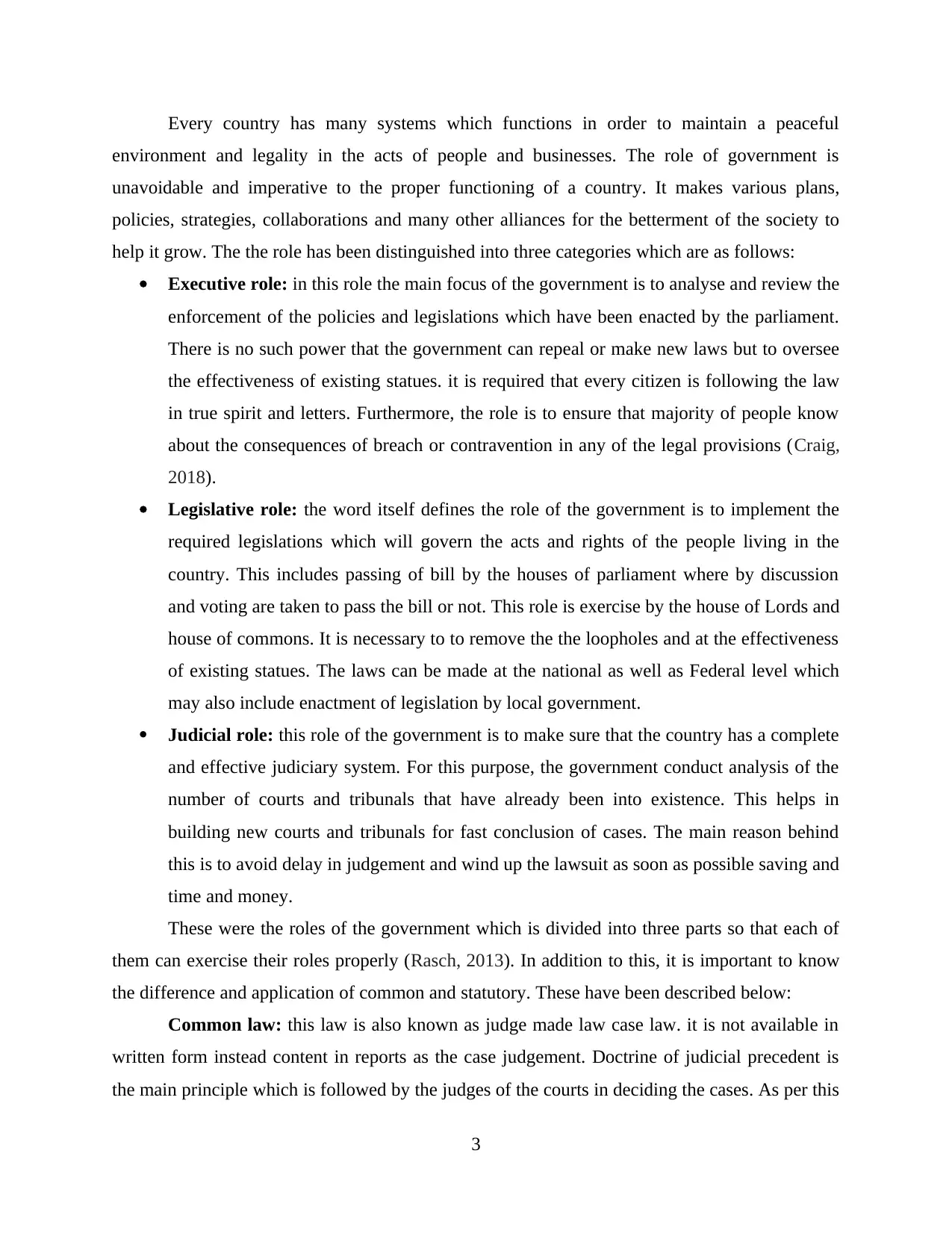
Every country has many systems which functions in order to maintain a peaceful
environment and legality in the acts of people and businesses. The role of government is
unavoidable and imperative to the proper functioning of a country. It makes various plans,
policies, strategies, collaborations and many other alliances for the betterment of the society to
help it grow. The the role has been distinguished into three categories which are as follows:
Executive role: in this role the main focus of the government is to analyse and review the
enforcement of the policies and legislations which have been enacted by the parliament.
There is no such power that the government can repeal or make new laws but to oversee
the effectiveness of existing statues. it is required that every citizen is following the law
in true spirit and letters. Furthermore, the role is to ensure that majority of people know
about the consequences of breach or contravention in any of the legal provisions (Craig,
2018).
Legislative role: the word itself defines the role of the government is to implement the
required legislations which will govern the acts and rights of the people living in the
country. This includes passing of bill by the houses of parliament where by discussion
and voting are taken to pass the bill or not. This role is exercise by the house of Lords and
house of commons. It is necessary to to remove the the loopholes and at the effectiveness
of existing statues. The laws can be made at the national as well as Federal level which
may also include enactment of legislation by local government.
Judicial role: this role of the government is to make sure that the country has a complete
and effective judiciary system. For this purpose, the government conduct analysis of the
number of courts and tribunals that have already been into existence. This helps in
building new courts and tribunals for fast conclusion of cases. The main reason behind
this is to avoid delay in judgement and wind up the lawsuit as soon as possible saving and
time and money.
These were the roles of the government which is divided into three parts so that each of
them can exercise their roles properly (Rasch, 2013). In addition to this, it is important to know
the difference and application of common and statutory. These have been described below:
Common law: this law is also known as judge made law case law. it is not available in
written form instead content in reports as the case judgement. Doctrine of judicial precedent is
the main principle which is followed by the judges of the courts in deciding the cases. As per this
3
environment and legality in the acts of people and businesses. The role of government is
unavoidable and imperative to the proper functioning of a country. It makes various plans,
policies, strategies, collaborations and many other alliances for the betterment of the society to
help it grow. The the role has been distinguished into three categories which are as follows:
Executive role: in this role the main focus of the government is to analyse and review the
enforcement of the policies and legislations which have been enacted by the parliament.
There is no such power that the government can repeal or make new laws but to oversee
the effectiveness of existing statues. it is required that every citizen is following the law
in true spirit and letters. Furthermore, the role is to ensure that majority of people know
about the consequences of breach or contravention in any of the legal provisions (Craig,
2018).
Legislative role: the word itself defines the role of the government is to implement the
required legislations which will govern the acts and rights of the people living in the
country. This includes passing of bill by the houses of parliament where by discussion
and voting are taken to pass the bill or not. This role is exercise by the house of Lords and
house of commons. It is necessary to to remove the the loopholes and at the effectiveness
of existing statues. The laws can be made at the national as well as Federal level which
may also include enactment of legislation by local government.
Judicial role: this role of the government is to make sure that the country has a complete
and effective judiciary system. For this purpose, the government conduct analysis of the
number of courts and tribunals that have already been into existence. This helps in
building new courts and tribunals for fast conclusion of cases. The main reason behind
this is to avoid delay in judgement and wind up the lawsuit as soon as possible saving and
time and money.
These were the roles of the government which is divided into three parts so that each of
them can exercise their roles properly (Rasch, 2013). In addition to this, it is important to know
the difference and application of common and statutory. These have been described below:
Common law: this law is also known as judge made law case law. it is not available in
written form instead content in reports as the case judgement. Doctrine of judicial precedent is
the main principle which is followed by the judges of the courts in deciding the cases. As per this
3
⊘ This is a preview!⊘
Do you want full access?
Subscribe today to unlock all pages.

Trusted by 1+ million students worldwide
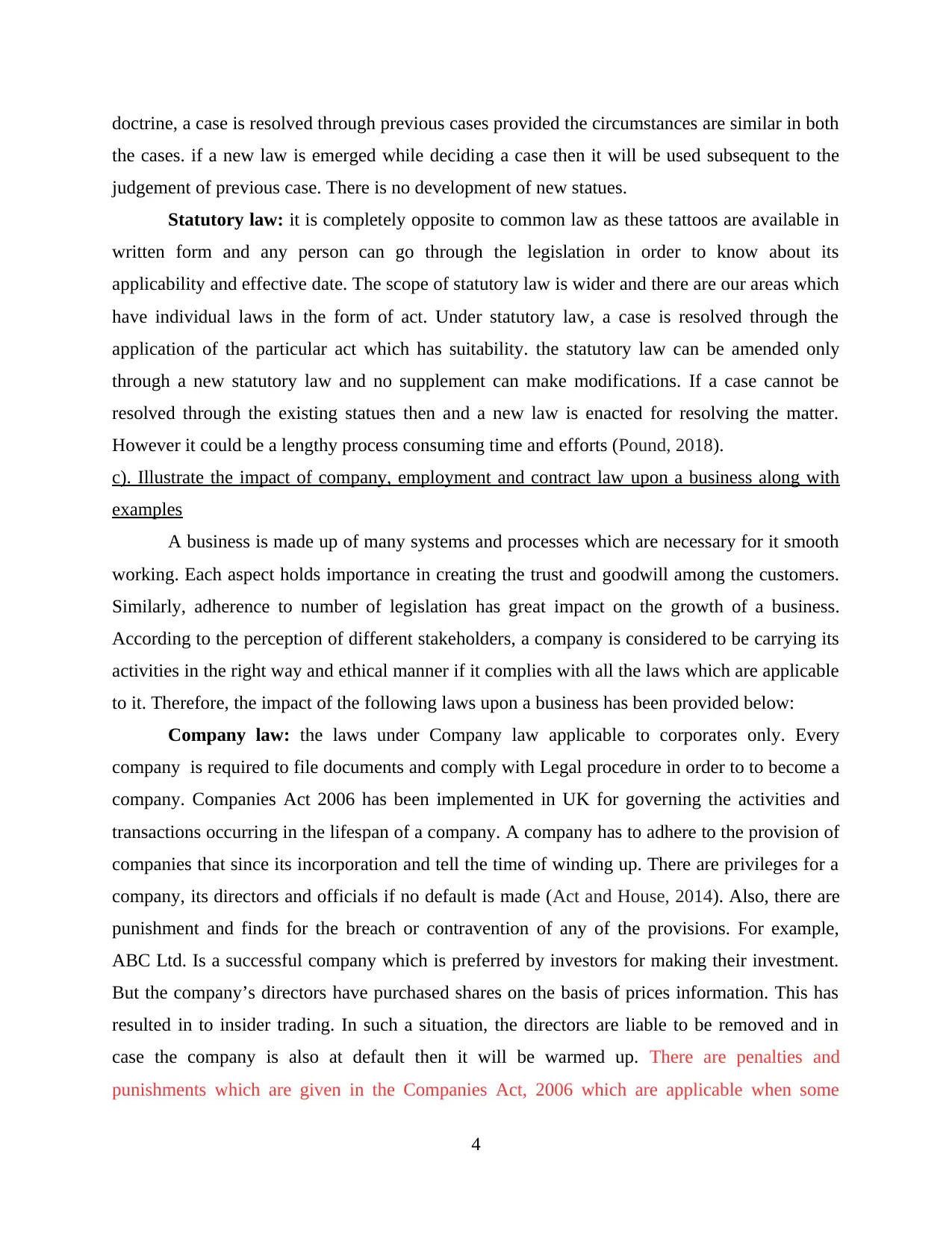
doctrine, a case is resolved through previous cases provided the circumstances are similar in both
the cases. if a new law is emerged while deciding a case then it will be used subsequent to the
judgement of previous case. There is no development of new statues.
Statutory law: it is completely opposite to common law as these tattoos are available in
written form and any person can go through the legislation in order to know about its
applicability and effective date. The scope of statutory law is wider and there are our areas which
have individual laws in the form of act. Under statutory law, a case is resolved through the
application of the particular act which has suitability. the statutory law can be amended only
through a new statutory law and no supplement can make modifications. If a case cannot be
resolved through the existing statues then and a new law is enacted for resolving the matter.
However it could be a lengthy process consuming time and efforts (Pound, 2018).
c). Illustrate the impact of company, employment and contract law upon a business along with
examples
A business is made up of many systems and processes which are necessary for it smooth
working. Each aspect holds importance in creating the trust and goodwill among the customers.
Similarly, adherence to number of legislation has great impact on the growth of a business.
According to the perception of different stakeholders, a company is considered to be carrying its
activities in the right way and ethical manner if it complies with all the laws which are applicable
to it. Therefore, the impact of the following laws upon a business has been provided below:
Company law: the laws under Company law applicable to corporates only. Every
company is required to file documents and comply with Legal procedure in order to to become a
company. Companies Act 2006 has been implemented in UK for governing the activities and
transactions occurring in the lifespan of a company. A company has to adhere to the provision of
companies that since its incorporation and tell the time of winding up. There are privileges for a
company, its directors and officials if no default is made (Act and House, 2014). Also, there are
punishment and finds for the breach or contravention of any of the provisions. For example,
ABC Ltd. Is a successful company which is preferred by investors for making their investment.
But the company’s directors have purchased shares on the basis of prices information. This has
resulted in to insider trading. In such a situation, the directors are liable to be removed and in
case the company is also at default then it will be warmed up. There are penalties and
punishments which are given in the Companies Act, 2006 which are applicable when some
4
the cases. if a new law is emerged while deciding a case then it will be used subsequent to the
judgement of previous case. There is no development of new statues.
Statutory law: it is completely opposite to common law as these tattoos are available in
written form and any person can go through the legislation in order to know about its
applicability and effective date. The scope of statutory law is wider and there are our areas which
have individual laws in the form of act. Under statutory law, a case is resolved through the
application of the particular act which has suitability. the statutory law can be amended only
through a new statutory law and no supplement can make modifications. If a case cannot be
resolved through the existing statues then and a new law is enacted for resolving the matter.
However it could be a lengthy process consuming time and efforts (Pound, 2018).
c). Illustrate the impact of company, employment and contract law upon a business along with
examples
A business is made up of many systems and processes which are necessary for it smooth
working. Each aspect holds importance in creating the trust and goodwill among the customers.
Similarly, adherence to number of legislation has great impact on the growth of a business.
According to the perception of different stakeholders, a company is considered to be carrying its
activities in the right way and ethical manner if it complies with all the laws which are applicable
to it. Therefore, the impact of the following laws upon a business has been provided below:
Company law: the laws under Company law applicable to corporates only. Every
company is required to file documents and comply with Legal procedure in order to to become a
company. Companies Act 2006 has been implemented in UK for governing the activities and
transactions occurring in the lifespan of a company. A company has to adhere to the provision of
companies that since its incorporation and tell the time of winding up. There are privileges for a
company, its directors and officials if no default is made (Act and House, 2014). Also, there are
punishment and finds for the breach or contravention of any of the provisions. For example,
ABC Ltd. Is a successful company which is preferred by investors for making their investment.
But the company’s directors have purchased shares on the basis of prices information. This has
resulted in to insider trading. In such a situation, the directors are liable to be removed and in
case the company is also at default then it will be warmed up. There are penalties and
punishments which are given in the Companies Act, 2006 which are applicable when some
4
Paraphrase This Document
Need a fresh take? Get an instant paraphrase of this document with our AI Paraphraser
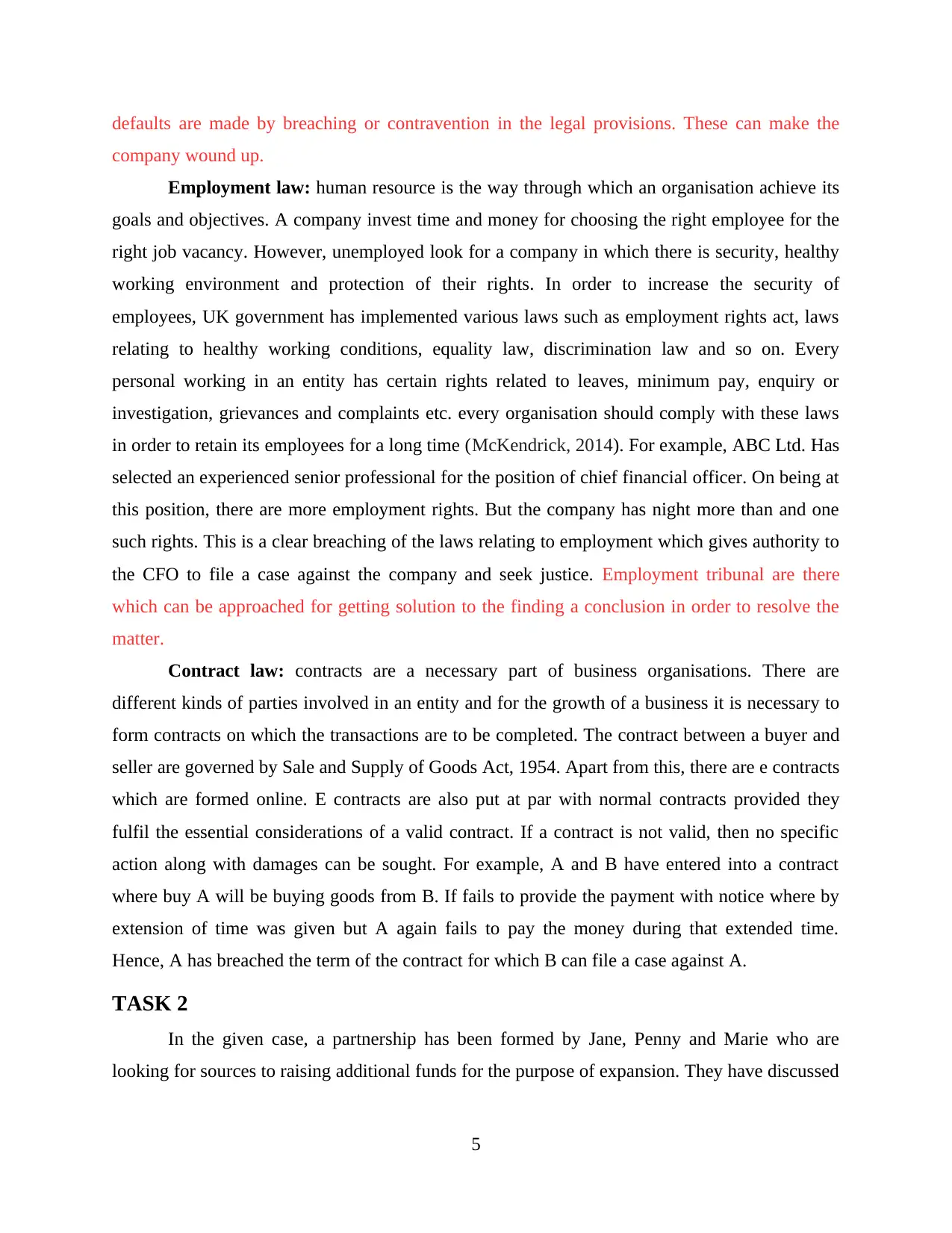
defaults are made by breaching or contravention in the legal provisions. These can make the
company wound up.
Employment law: human resource is the way through which an organisation achieve its
goals and objectives. A company invest time and money for choosing the right employee for the
right job vacancy. However, unemployed look for a company in which there is security, healthy
working environment and protection of their rights. In order to increase the security of
employees, UK government has implemented various laws such as employment rights act, laws
relating to healthy working conditions, equality law, discrimination law and so on. Every
personal working in an entity has certain rights related to leaves, minimum pay, enquiry or
investigation, grievances and complaints etc. every organisation should comply with these laws
in order to retain its employees for a long time (McKendrick, 2014). For example, ABC Ltd. Has
selected an experienced senior professional for the position of chief financial officer. On being at
this position, there are more employment rights. But the company has night more than and one
such rights. This is a clear breaching of the laws relating to employment which gives authority to
the CFO to file a case against the company and seek justice. Employment tribunal are there
which can be approached for getting solution to the finding a conclusion in order to resolve the
matter.
Contract law: contracts are a necessary part of business organisations. There are
different kinds of parties involved in an entity and for the growth of a business it is necessary to
form contracts on which the transactions are to be completed. The contract between a buyer and
seller are governed by Sale and Supply of Goods Act, 1954. Apart from this, there are e contracts
which are formed online. E contracts are also put at par with normal contracts provided they
fulfil the essential considerations of a valid contract. If a contract is not valid, then no specific
action along with damages can be sought. For example, A and B have entered into a contract
where buy A will be buying goods from B. If fails to provide the payment with notice where by
extension of time was given but A again fails to pay the money during that extended time.
Hence, A has breached the term of the contract for which B can file a case against A.
TASK 2
In the given case, a partnership has been formed by Jane, Penny and Marie who are
looking for sources to raising additional funds for the purpose of expansion. They have discussed
5
company wound up.
Employment law: human resource is the way through which an organisation achieve its
goals and objectives. A company invest time and money for choosing the right employee for the
right job vacancy. However, unemployed look for a company in which there is security, healthy
working environment and protection of their rights. In order to increase the security of
employees, UK government has implemented various laws such as employment rights act, laws
relating to healthy working conditions, equality law, discrimination law and so on. Every
personal working in an entity has certain rights related to leaves, minimum pay, enquiry or
investigation, grievances and complaints etc. every organisation should comply with these laws
in order to retain its employees for a long time (McKendrick, 2014). For example, ABC Ltd. Has
selected an experienced senior professional for the position of chief financial officer. On being at
this position, there are more employment rights. But the company has night more than and one
such rights. This is a clear breaching of the laws relating to employment which gives authority to
the CFO to file a case against the company and seek justice. Employment tribunal are there
which can be approached for getting solution to the finding a conclusion in order to resolve the
matter.
Contract law: contracts are a necessary part of business organisations. There are
different kinds of parties involved in an entity and for the growth of a business it is necessary to
form contracts on which the transactions are to be completed. The contract between a buyer and
seller are governed by Sale and Supply of Goods Act, 1954. Apart from this, there are e contracts
which are formed online. E contracts are also put at par with normal contracts provided they
fulfil the essential considerations of a valid contract. If a contract is not valid, then no specific
action along with damages can be sought. For example, A and B have entered into a contract
where buy A will be buying goods from B. If fails to provide the payment with notice where by
extension of time was given but A again fails to pay the money during that extended time.
Hence, A has breached the term of the contract for which B can file a case against A.
TASK 2
In the given case, a partnership has been formed by Jane, Penny and Marie who are
looking for sources to raising additional funds for the purpose of expansion. They have discussed
5
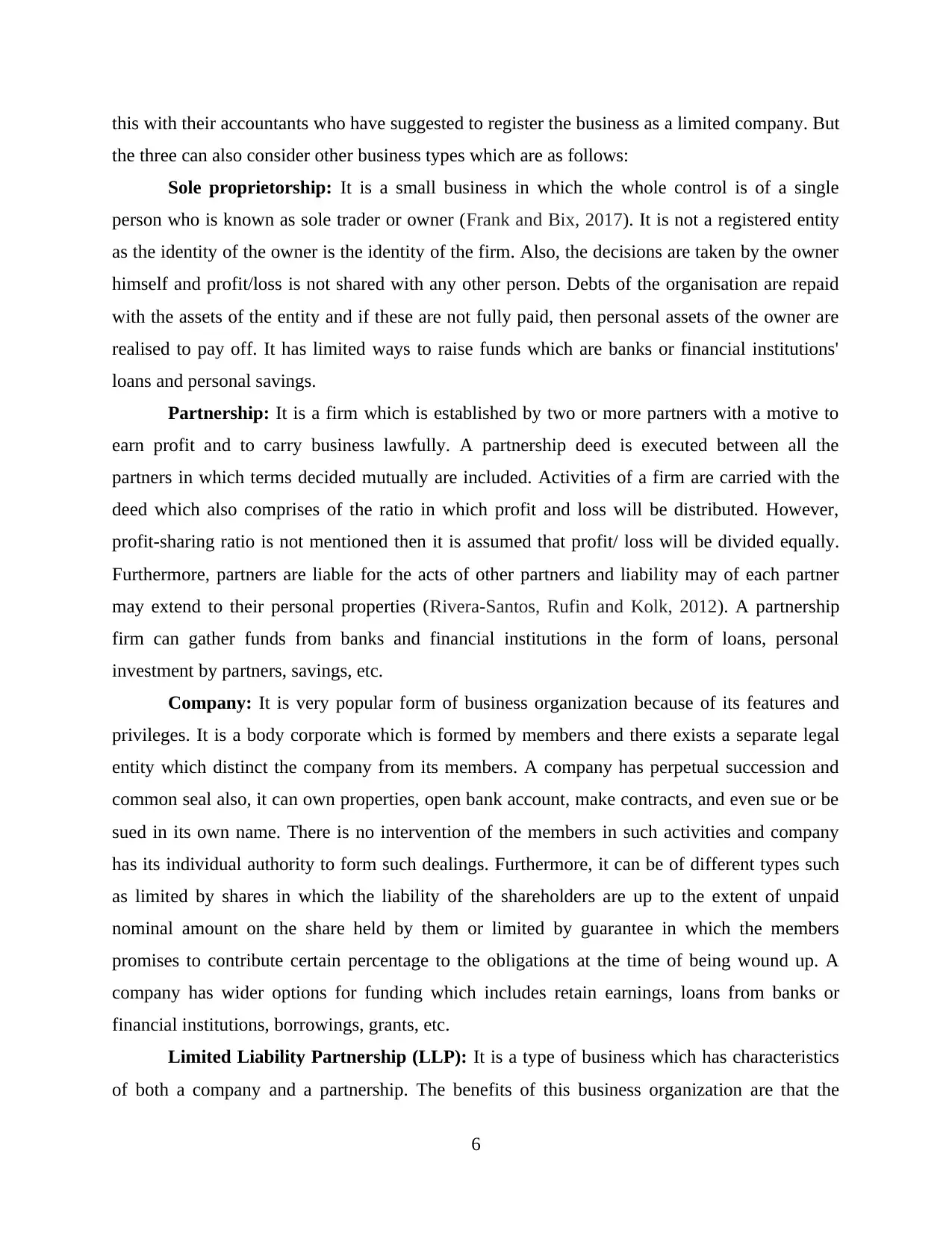
this with their accountants who have suggested to register the business as a limited company. But
the three can also consider other business types which are as follows:
Sole proprietorship: It is a small business in which the whole control is of a single
person who is known as sole trader or owner (Frank and Bix, 2017). It is not a registered entity
as the identity of the owner is the identity of the firm. Also, the decisions are taken by the owner
himself and profit/loss is not shared with any other person. Debts of the organisation are repaid
with the assets of the entity and if these are not fully paid, then personal assets of the owner are
realised to pay off. It has limited ways to raise funds which are banks or financial institutions'
loans and personal savings.
Partnership: It is a firm which is established by two or more partners with a motive to
earn profit and to carry business lawfully. A partnership deed is executed between all the
partners in which terms decided mutually are included. Activities of a firm are carried with the
deed which also comprises of the ratio in which profit and loss will be distributed. However,
profit-sharing ratio is not mentioned then it is assumed that profit/ loss will be divided equally.
Furthermore, partners are liable for the acts of other partners and liability may of each partner
may extend to their personal properties (Rivera-Santos, Rufin and Kolk, 2012). A partnership
firm can gather funds from banks and financial institutions in the form of loans, personal
investment by partners, savings, etc.
Company: It is very popular form of business organization because of its features and
privileges. It is a body corporate which is formed by members and there exists a separate legal
entity which distinct the company from its members. A company has perpetual succession and
common seal also, it can own properties, open bank account, make contracts, and even sue or be
sued in its own name. There is no intervention of the members in such activities and company
has its individual authority to form such dealings. Furthermore, it can be of different types such
as limited by shares in which the liability of the shareholders are up to the extent of unpaid
nominal amount on the share held by them or limited by guarantee in which the members
promises to contribute certain percentage to the obligations at the time of being wound up. A
company has wider options for funding which includes retain earnings, loans from banks or
financial institutions, borrowings, grants, etc.
Limited Liability Partnership (LLP): It is a type of business which has characteristics
of both a company and a partnership. The benefits of this business organization are that the
6
the three can also consider other business types which are as follows:
Sole proprietorship: It is a small business in which the whole control is of a single
person who is known as sole trader or owner (Frank and Bix, 2017). It is not a registered entity
as the identity of the owner is the identity of the firm. Also, the decisions are taken by the owner
himself and profit/loss is not shared with any other person. Debts of the organisation are repaid
with the assets of the entity and if these are not fully paid, then personal assets of the owner are
realised to pay off. It has limited ways to raise funds which are banks or financial institutions'
loans and personal savings.
Partnership: It is a firm which is established by two or more partners with a motive to
earn profit and to carry business lawfully. A partnership deed is executed between all the
partners in which terms decided mutually are included. Activities of a firm are carried with the
deed which also comprises of the ratio in which profit and loss will be distributed. However,
profit-sharing ratio is not mentioned then it is assumed that profit/ loss will be divided equally.
Furthermore, partners are liable for the acts of other partners and liability may of each partner
may extend to their personal properties (Rivera-Santos, Rufin and Kolk, 2012). A partnership
firm can gather funds from banks and financial institutions in the form of loans, personal
investment by partners, savings, etc.
Company: It is very popular form of business organization because of its features and
privileges. It is a body corporate which is formed by members and there exists a separate legal
entity which distinct the company from its members. A company has perpetual succession and
common seal also, it can own properties, open bank account, make contracts, and even sue or be
sued in its own name. There is no intervention of the members in such activities and company
has its individual authority to form such dealings. Furthermore, it can be of different types such
as limited by shares in which the liability of the shareholders are up to the extent of unpaid
nominal amount on the share held by them or limited by guarantee in which the members
promises to contribute certain percentage to the obligations at the time of being wound up. A
company has wider options for funding which includes retain earnings, loans from banks or
financial institutions, borrowings, grants, etc.
Limited Liability Partnership (LLP): It is a type of business which has characteristics
of both a company and a partnership. The benefits of this business organization are that the
6
⊘ This is a preview!⊘
Do you want full access?
Subscribe today to unlock all pages.

Trusted by 1+ million students worldwide
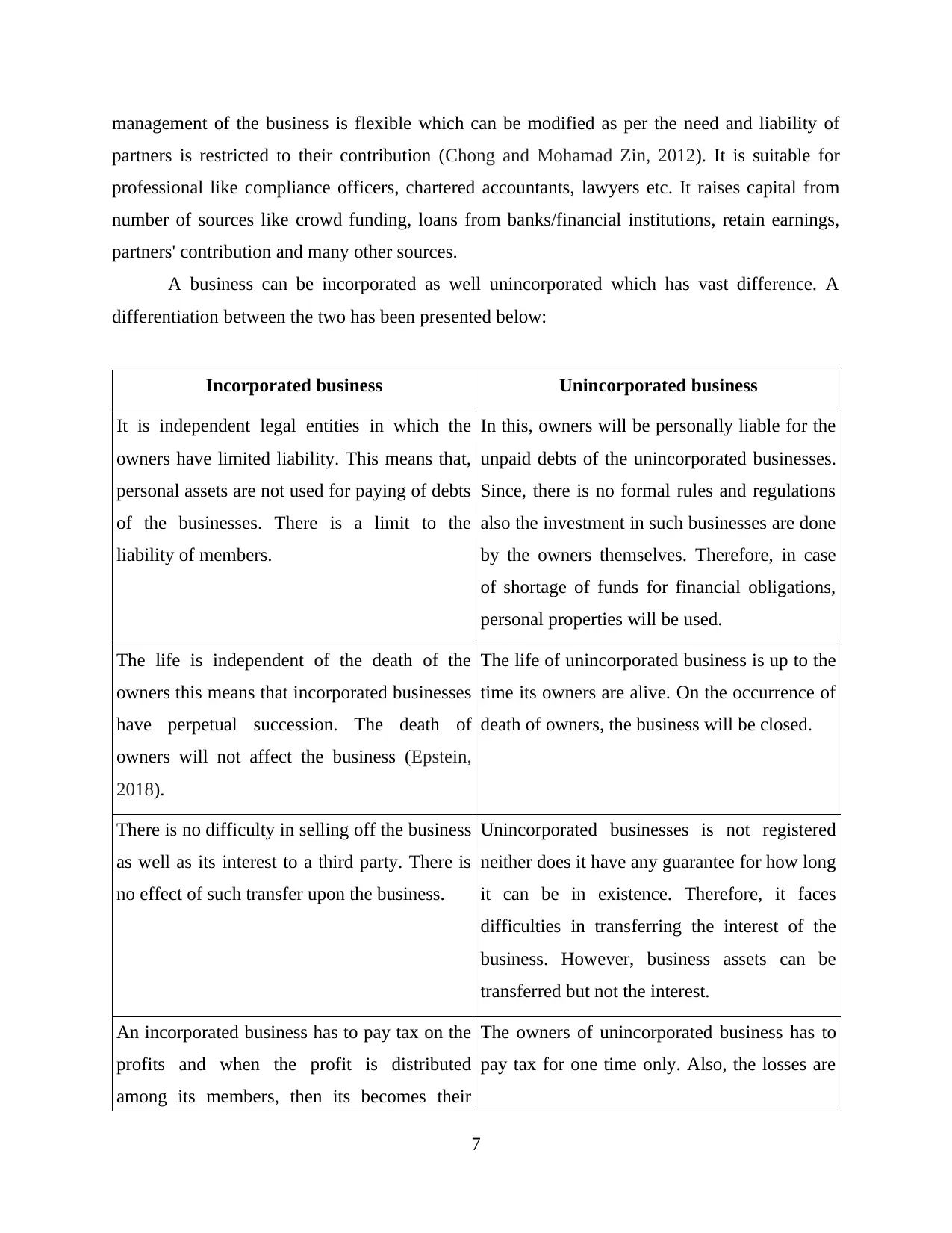
management of the business is flexible which can be modified as per the need and liability of
partners is restricted to their contribution (Chong and Mohamad Zin, 2012). It is suitable for
professional like compliance officers, chartered accountants, lawyers etc. It raises capital from
number of sources like crowd funding, loans from banks/financial institutions, retain earnings,
partners' contribution and many other sources.
A business can be incorporated as well unincorporated which has vast difference. A
differentiation between the two has been presented below:
Incorporated business Unincorporated business
It is independent legal entities in which the
owners have limited liability. This means that,
personal assets are not used for paying of debts
of the businesses. There is a limit to the
liability of members.
In this, owners will be personally liable for the
unpaid debts of the unincorporated businesses.
Since, there is no formal rules and regulations
also the investment in such businesses are done
by the owners themselves. Therefore, in case
of shortage of funds for financial obligations,
personal properties will be used.
The life is independent of the death of the
owners this means that incorporated businesses
have perpetual succession. The death of
owners will not affect the business (Epstein,
2018).
The life of unincorporated business is up to the
time its owners are alive. On the occurrence of
death of owners, the business will be closed.
There is no difficulty in selling off the business
as well as its interest to a third party. There is
no effect of such transfer upon the business.
Unincorporated businesses is not registered
neither does it have any guarantee for how long
it can be in existence. Therefore, it faces
difficulties in transferring the interest of the
business. However, business assets can be
transferred but not the interest.
An incorporated business has to pay tax on the
profits and when the profit is distributed
among its members, then its becomes their
The owners of unincorporated business has to
pay tax for one time only. Also, the losses are
7
partners is restricted to their contribution (Chong and Mohamad Zin, 2012). It is suitable for
professional like compliance officers, chartered accountants, lawyers etc. It raises capital from
number of sources like crowd funding, loans from banks/financial institutions, retain earnings,
partners' contribution and many other sources.
A business can be incorporated as well unincorporated which has vast difference. A
differentiation between the two has been presented below:
Incorporated business Unincorporated business
It is independent legal entities in which the
owners have limited liability. This means that,
personal assets are not used for paying of debts
of the businesses. There is a limit to the
liability of members.
In this, owners will be personally liable for the
unpaid debts of the unincorporated businesses.
Since, there is no formal rules and regulations
also the investment in such businesses are done
by the owners themselves. Therefore, in case
of shortage of funds for financial obligations,
personal properties will be used.
The life is independent of the death of the
owners this means that incorporated businesses
have perpetual succession. The death of
owners will not affect the business (Epstein,
2018).
The life of unincorporated business is up to the
time its owners are alive. On the occurrence of
death of owners, the business will be closed.
There is no difficulty in selling off the business
as well as its interest to a third party. There is
no effect of such transfer upon the business.
Unincorporated businesses is not registered
neither does it have any guarantee for how long
it can be in existence. Therefore, it faces
difficulties in transferring the interest of the
business. However, business assets can be
transferred but not the interest.
An incorporated business has to pay tax on the
profits and when the profit is distributed
among its members, then its becomes their
The owners of unincorporated business has to
pay tax for one time only. Also, the losses are
7
Paraphrase This Document
Need a fresh take? Get an instant paraphrase of this document with our AI Paraphraser
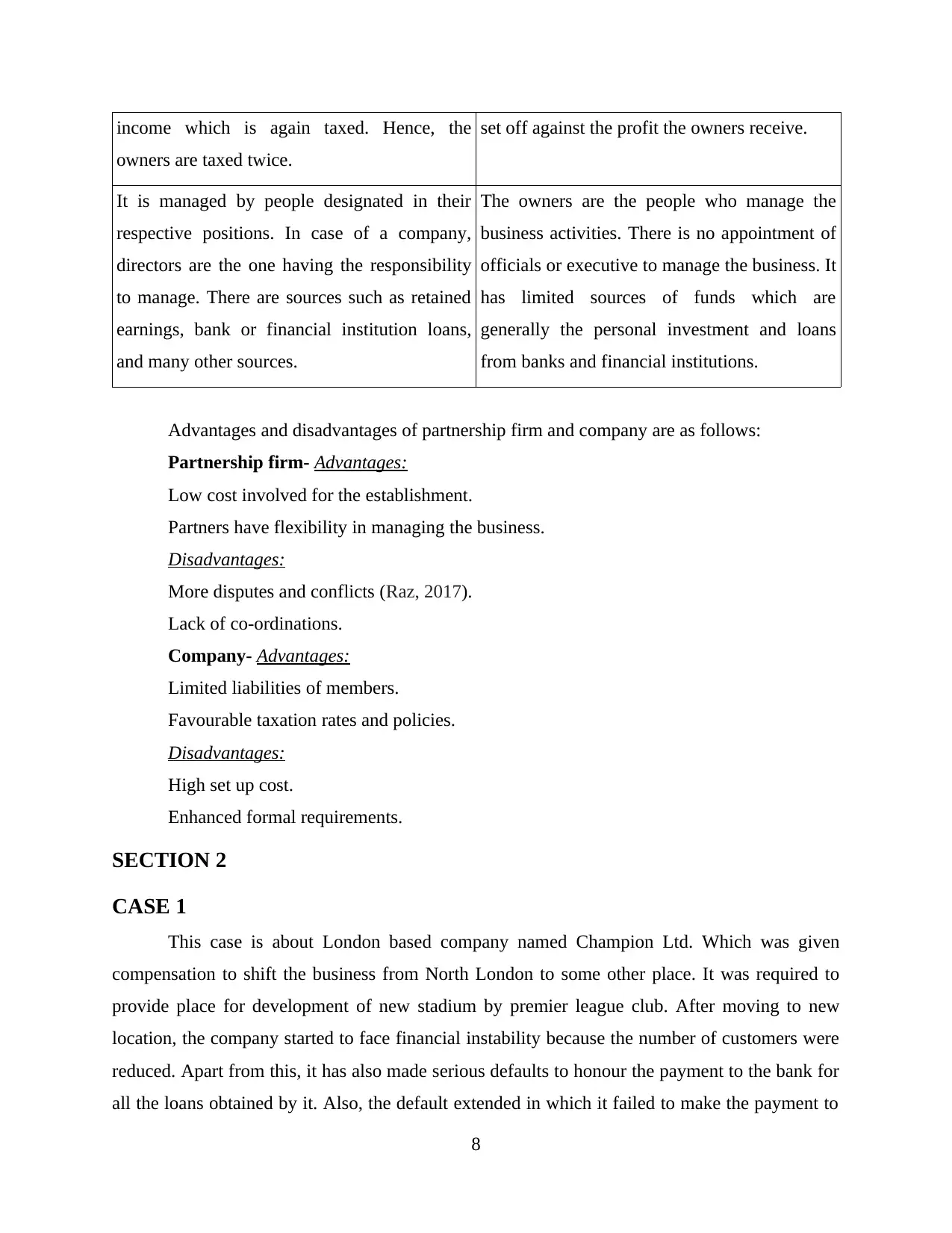
income which is again taxed. Hence, the
owners are taxed twice.
set off against the profit the owners receive.
It is managed by people designated in their
respective positions. In case of a company,
directors are the one having the responsibility
to manage. There are sources such as retained
earnings, bank or financial institution loans,
and many other sources.
The owners are the people who manage the
business activities. There is no appointment of
officials or executive to manage the business. It
has limited sources of funds which are
generally the personal investment and loans
from banks and financial institutions.
Advantages and disadvantages of partnership firm and company are as follows:
Partnership firm- Advantages:
Low cost involved for the establishment.
Partners have flexibility in managing the business.
Disadvantages:
More disputes and conflicts (Raz, 2017).
Lack of co-ordinations.
Company- Advantages:
Limited liabilities of members.
Favourable taxation rates and policies.
Disadvantages:
High set up cost.
Enhanced formal requirements.
SECTION 2
CASE 1
This case is about London based company named Champion Ltd. Which was given
compensation to shift the business from North London to some other place. It was required to
provide place for development of new stadium by premier league club. After moving to new
location, the company started to face financial instability because the number of customers were
reduced. Apart from this, it has also made serious defaults to honour the payment to the bank for
all the loans obtained by it. Also, the default extended in which it failed to make the payment to
8
owners are taxed twice.
set off against the profit the owners receive.
It is managed by people designated in their
respective positions. In case of a company,
directors are the one having the responsibility
to manage. There are sources such as retained
earnings, bank or financial institution loans,
and many other sources.
The owners are the people who manage the
business activities. There is no appointment of
officials or executive to manage the business. It
has limited sources of funds which are
generally the personal investment and loans
from banks and financial institutions.
Advantages and disadvantages of partnership firm and company are as follows:
Partnership firm- Advantages:
Low cost involved for the establishment.
Partners have flexibility in managing the business.
Disadvantages:
More disputes and conflicts (Raz, 2017).
Lack of co-ordinations.
Company- Advantages:
Limited liabilities of members.
Favourable taxation rates and policies.
Disadvantages:
High set up cost.
Enhanced formal requirements.
SECTION 2
CASE 1
This case is about London based company named Champion Ltd. Which was given
compensation to shift the business from North London to some other place. It was required to
provide place for development of new stadium by premier league club. After moving to new
location, the company started to face financial instability because the number of customers were
reduced. Apart from this, it has also made serious defaults to honour the payment to the bank for
all the loans obtained by it. Also, the default extended in which it failed to make the payment to
8
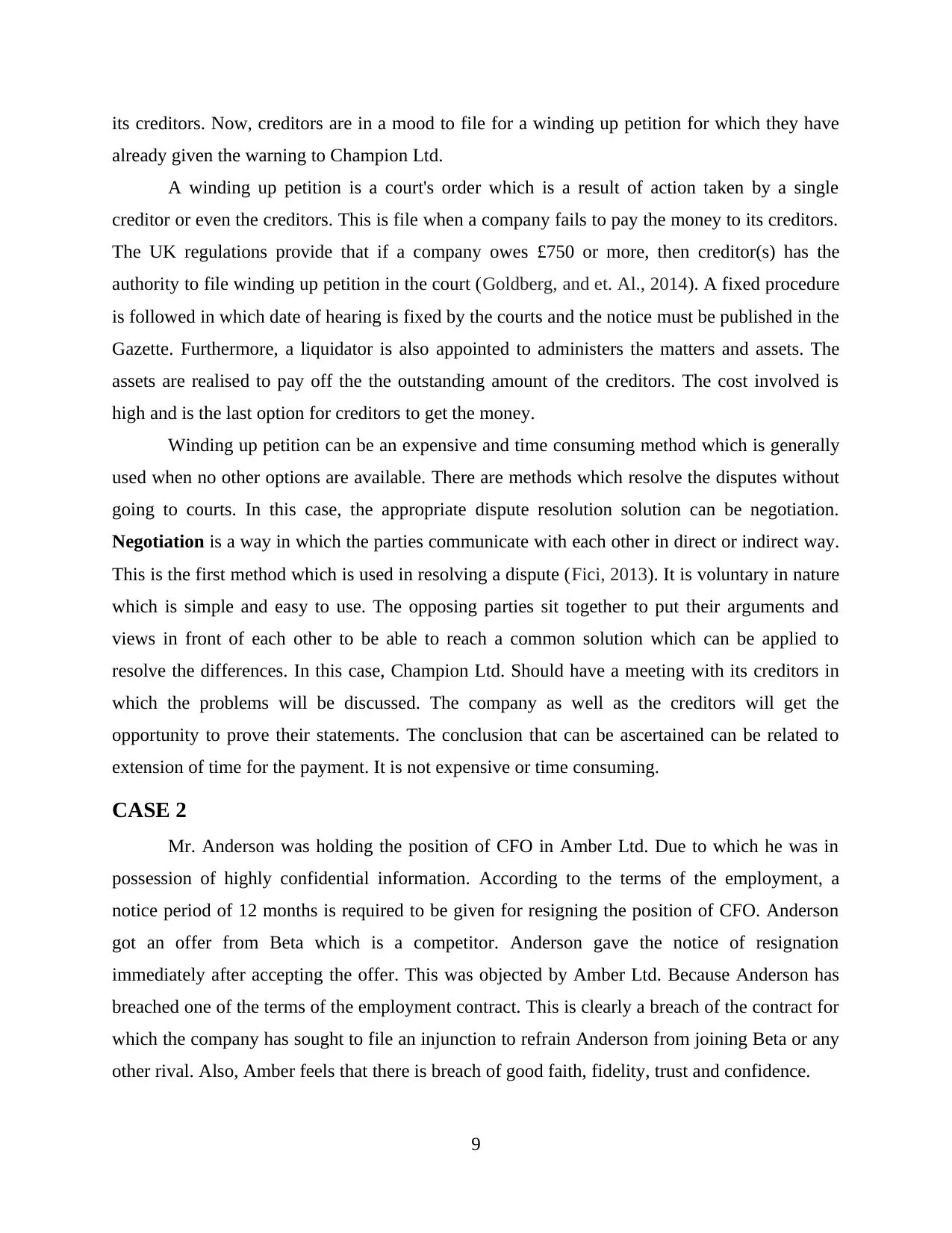
its creditors. Now, creditors are in a mood to file for a winding up petition for which they have
already given the warning to Champion Ltd.
A winding up petition is a court's order which is a result of action taken by a single
creditor or even the creditors. This is file when a company fails to pay the money to its creditors.
The UK regulations provide that if a company owes £750 or more, then creditor(s) has the
authority to file winding up petition in the court (Goldberg, and et. Al., 2014). A fixed procedure
is followed in which date of hearing is fixed by the courts and the notice must be published in the
Gazette. Furthermore, a liquidator is also appointed to administers the matters and assets. The
assets are realised to pay off the the outstanding amount of the creditors. The cost involved is
high and is the last option for creditors to get the money.
Winding up petition can be an expensive and time consuming method which is generally
used when no other options are available. There are methods which resolve the disputes without
going to courts. In this case, the appropriate dispute resolution solution can be negotiation.
Negotiation is a way in which the parties communicate with each other in direct or indirect way.
This is the first method which is used in resolving a dispute (Fici, 2013). It is voluntary in nature
which is simple and easy to use. The opposing parties sit together to put their arguments and
views in front of each other to be able to reach a common solution which can be applied to
resolve the differences. In this case, Champion Ltd. Should have a meeting with its creditors in
which the problems will be discussed. The company as well as the creditors will get the
opportunity to prove their statements. The conclusion that can be ascertained can be related to
extension of time for the payment. It is not expensive or time consuming.
CASE 2
Mr. Anderson was holding the position of CFO in Amber Ltd. Due to which he was in
possession of highly confidential information. According to the terms of the employment, a
notice period of 12 months is required to be given for resigning the position of CFO. Anderson
got an offer from Beta which is a competitor. Anderson gave the notice of resignation
immediately after accepting the offer. This was objected by Amber Ltd. Because Anderson has
breached one of the terms of the employment contract. This is clearly a breach of the contract for
which the company has sought to file an injunction to refrain Anderson from joining Beta or any
other rival. Also, Amber feels that there is breach of good faith, fidelity, trust and confidence.
9
already given the warning to Champion Ltd.
A winding up petition is a court's order which is a result of action taken by a single
creditor or even the creditors. This is file when a company fails to pay the money to its creditors.
The UK regulations provide that if a company owes £750 or more, then creditor(s) has the
authority to file winding up petition in the court (Goldberg, and et. Al., 2014). A fixed procedure
is followed in which date of hearing is fixed by the courts and the notice must be published in the
Gazette. Furthermore, a liquidator is also appointed to administers the matters and assets. The
assets are realised to pay off the the outstanding amount of the creditors. The cost involved is
high and is the last option for creditors to get the money.
Winding up petition can be an expensive and time consuming method which is generally
used when no other options are available. There are methods which resolve the disputes without
going to courts. In this case, the appropriate dispute resolution solution can be negotiation.
Negotiation is a way in which the parties communicate with each other in direct or indirect way.
This is the first method which is used in resolving a dispute (Fici, 2013). It is voluntary in nature
which is simple and easy to use. The opposing parties sit together to put their arguments and
views in front of each other to be able to reach a common solution which can be applied to
resolve the differences. In this case, Champion Ltd. Should have a meeting with its creditors in
which the problems will be discussed. The company as well as the creditors will get the
opportunity to prove their statements. The conclusion that can be ascertained can be related to
extension of time for the payment. It is not expensive or time consuming.
CASE 2
Mr. Anderson was holding the position of CFO in Amber Ltd. Due to which he was in
possession of highly confidential information. According to the terms of the employment, a
notice period of 12 months is required to be given for resigning the position of CFO. Anderson
got an offer from Beta which is a competitor. Anderson gave the notice of resignation
immediately after accepting the offer. This was objected by Amber Ltd. Because Anderson has
breached one of the terms of the employment contract. This is clearly a breach of the contract for
which the company has sought to file an injunction to refrain Anderson from joining Beta or any
other rival. Also, Amber feels that there is breach of good faith, fidelity, trust and confidence.
9
⊘ This is a preview!⊘
Do you want full access?
Subscribe today to unlock all pages.

Trusted by 1+ million students worldwide
1 out of 15
Related Documents
Your All-in-One AI-Powered Toolkit for Academic Success.
+13062052269
info@desklib.com
Available 24*7 on WhatsApp / Email
![[object Object]](/_next/static/media/star-bottom.7253800d.svg)
Unlock your academic potential
Copyright © 2020–2025 A2Z Services. All Rights Reserved. Developed and managed by ZUCOL.




